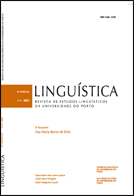Rethinking Depictive Secondary Predicates. A Pair- Merge approach and the Adjunct Condition
Resumo
In this article I will propose a new analysis of depictive secondary predication structures. Previous studies of these structures are framed within different approaches: C-command / categorial approaches (Williams 1980, Rothstein 1983, 2001, Demonte 1988, Mallén 1991, Bowers 1993, among others), C-command and Multiple Agree approaches (McNulty 1988, Irimia 2012), linearization after ‘Lateral Movement’ and attachment of identical eventive heads (Gallar 2017), or Parallel-Merge approaches (Irimia 2012, You 2016). Following Chomsky (2019) and Bošković (2020), among others, I will claim here, first, that adjunct depictive secondary predicates start as members of a Pair-MERGE(d) conjunction/ adjunction structure which is unlabeled. There are as many members of these pair merged phrases as modifiers in a sentence, and they are unbounded and unstructured. Pair merged structures are in principle opaque and non-sensible to syntactic operations. However, since they are semantically and syntactically conjoined phrases they have each a Link element. This Link merges at the edge of the phase at which the modifier is conjoined thus allowing extraction out of the opaque domain. I will suggest that perhaps Tagalog expresses overtly these links. I will previously present a detailed description of the properties of DPS in Spanish.
Referências
Borgonovo, C. & Neeleman, Ad. 2000. Transparent Adjuncts. Canadian Journal of Linguistics 45: 199-224.
Bošković, Ž. 2014. Now I’m a phase, now I’m not a phase: On the variability of phases with extraction and ellipsis. Linguistic Inquiry 45(1): 27–89.
Bošković, Ž. 2018. On movement out of moved elements, labels, and phases. Linguistic Inquiry 49(2): 247–282.
Bošković, Ž. 2020. On the coordinate structure constraint and the adjunct condition. In: A. Bárány, T. Biberauer, J. Douglas & S. Vikner (eds.) Syntactic architecture and its consequences II. Between syntax and morphology. Berlin: Language Science Press, 227-258.
Bowers, J. 1993. The syntax of predication. Linguistic Inquiry 24: 591–656.
Bruce, Les. 1984. The Alamblak language of Papua New Guinea (East Sepik). Canberra: Pacific Linguistics.
Chomsky, N. 2004. Beyond explanatory adequacy. In: A. Belleti (ed.): Structures and Beyond. Oxford – New York: Oxford University Press, 104-131.
Chomsky, N. 2013. Problems of Projection. Lingua 130: 33-49.
Chomsky, N. 2019. The UCLA Lectures. Unpublished manuscript. University of Arizona / MIT.
Collins, C. 2017. Merge (X, Y) = {X, Y}. In: L. S. Bauke & A. Blümel (eds.), Labels and roots. Berlin: De Gruyter: 47–68.
Demonte, V. 1988. Remarks on secondary predicates: C-command, extraction and reanalysis. The Linguistic Review. 6: 1–39.
Demonte, V. 1991. Temporal and aspectual constraints on predicative APs. In: H. Campos & F. Martínez-Gil (eds.). Current Studies in Spanish Linguistics. Georgetown: Georgetown University Press, 165-200.
Gallar, C. 2017. Adjuntos: Ampliación del Dominio Local y Formación de Cadenas. Una propuesta basada en el movimiento lateral. Tesis doctoral. Universidad Complutense de Madrid / CSIC.
Hornstein, N. 2009. A theory of syntax: Minimal operations and universal grammar. Cambridge: Cambridge University Press.
Huang, C.T-J.1982. Logical relations in Chinese and the theory of grammar. Doctoral dissertation, Cambridge, Ma.: MIT.
Irimia, M.-A. 2012. Secondary predicates. Doctoral dissertation. University of Toronto.
Mallén, E.1991. A syntactic analysis of secondary predication in Spanish. Journal of Linguistics 27: 375–403.
Maruta, T. 1995. The semantics of depictives. English Linguistic Society of Japan: English Linguistics 12: 125-146.
McNulty, E. M. 1988. The syntax of adjunct predicates. Doctoral Dissertation. University of Connecticut.
Napoli, Donna Jo. 1989. Predication theory. Cambridge: Cambridge University Press.
Nunes, J., & Uriagereka, J. 2000. Cyclicity and Extraction Domains. Syntax 3: 20–43.
Oseki, Y. 2015. Eliminating Pair-Merge. In: U. Steindl, T. Borer, H. Fang, A. García Pardo, P. Guekguezian, B. Hsu, Ch. O’Hara & I. Chuoying Ouyang (eds.), Proceedings of the 32nd West Coast Conference on Formal Linguistics. Somerville, MA: Cascadilla
Proceedings Project, 303-312.
Rothstein, S. 1983. The syntactic forms of predication. Doctoral dissertation, MIT, Cambridge, MA.
Rothstein, S. 2001. Predicates and their subjects. Dordrecht: Kluwer.
Rubin, E.J., 1994. Modification: A Syntactic Analysis and its Consequences. Doctoral dissertation. Cornell University, Ithaca: NY.
Scontras, G. & Nicolae, A. C. 2014. Saturating syntax: Linkers and modification in Tagalog. Lingua 149: Special issue on Modification at the interface, ed. by E. Castroviejo & B. Gehrke: 17-33.
Simpson, J. 1982. Secondary Predicates in English, Icelandic and Finnish, ma: MIT.
Song, C. 2020. Categorizing verb-internal modifiers. In: A. Bárány, T. Biberauer, J. Douglas & S. Vikner (eds.), Syntactic architecture and its consequences I: Syntax inside the grammar. Berlin: Language Science Press, 357–384.
Truswell, R. 2007. Extraction from adjuncts and the structure of events. Lingua 117: 1355-1377.
Truswell, R. 2011. Events, phrases, and questions. Oxford: Oxford University Press.
van der Auwera, Johan, & Andrej Malchucov. 2005. A semantic map for depictive adjectivals. In: N. Himmelmann & E. Schultze Berndt (eds.), Secondary predication and adverbial modification, Oxford: Oxford University Press, 393-421.
Williams, E. 1980. Predication. Linguistic Inquiry 11: 203-238.
Winkler, S. 1997. Focus and secondary predication. Berlin: Mouton de Gruyter.
You, E. 2016. Parallel derivation of Spanish depictive secondary predicates. Linguistic Inquiry 47 (4): 723–739.
Downloads
Publicado
Edição
Secção
Licença
Direitos de Autor (c) 2021 Linguística: Revista de Estudos Linguísticos da Universidade do Porto

Este trabalho encontra-se publicado com a Creative Commons Atribuição-NãoComercial 4.0.



